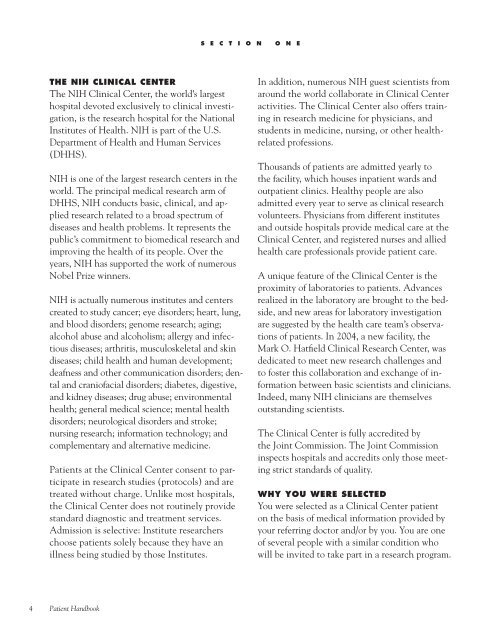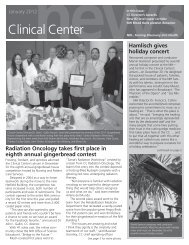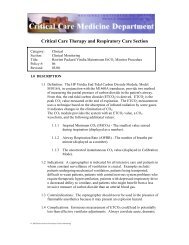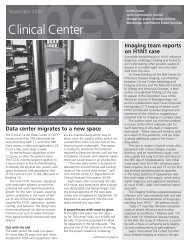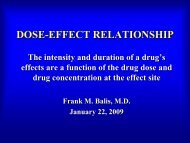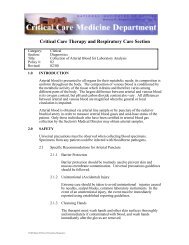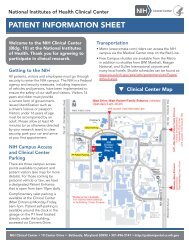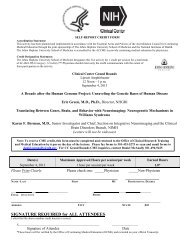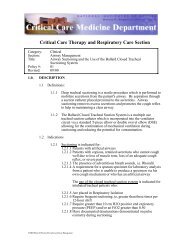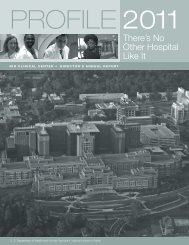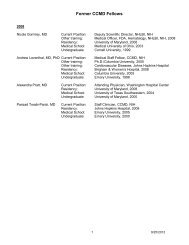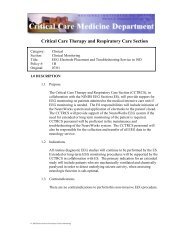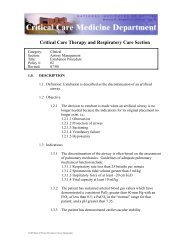Patient Handbook - NIH Clinical Center - National Institutes of Health
Patient Handbook - NIH Clinical Center - National Institutes of Health
Patient Handbook - NIH Clinical Center - National Institutes of Health
You also want an ePaper? Increase the reach of your titles
YUMPU automatically turns print PDFs into web optimized ePapers that Google loves.
THE <strong>NIH</strong> CLINICAL CENTER<br />
The <strong>NIH</strong> <strong>Clinical</strong> <strong>Center</strong>, the world’s largest<br />
hospital devoted exclusively to clinical investigation,<br />
is the research hospital for the <strong>National</strong><br />
<strong>Institutes</strong> <strong>of</strong> <strong>Health</strong>. <strong>NIH</strong> is part <strong>of</strong> the U.S.<br />
Department <strong>of</strong> <strong>Health</strong> and Human Services<br />
(DHHS).<br />
<strong>NIH</strong> is one <strong>of</strong> the largest research centers in the<br />
world. The principal medical research arm <strong>of</strong><br />
DHHS, <strong>NIH</strong> conducts basic, clinical, and applied<br />
research related to a broad spectrum <strong>of</strong><br />
diseases and health problems. It represents the<br />
public’s commitment to biomedical research and<br />
improving the health <strong>of</strong> its people. Over the<br />
years, <strong>NIH</strong> has supported the work <strong>of</strong> numerous<br />
Nobel Prize winners.<br />
<strong>NIH</strong> is actually numerous institutes and centers<br />
created to study cancer; eye disorders; heart, lung,<br />
and blood disorders; genome research; aging;<br />
alcohol abuse and alcoholism; allergy and infectious<br />
diseases; arthritis, musculoskeletal and skin<br />
diseases; child health and human development;<br />
deafness and other communication disorders; dental<br />
and crani<strong>of</strong>acial disorders; diabetes, digestive,<br />
and kidney diseases; drug abuse; environmental<br />
health; general medical science; mental health<br />
disorders; neurological disorders and stroke;<br />
nursing research; information technology; and<br />
complementary and alternative medicine.<br />
<strong>Patient</strong>s at the <strong>Clinical</strong> <strong>Center</strong> consent to participate<br />
in research studies (protocols) and are<br />
treated without charge. Unlike most hospitals,<br />
the <strong>Clinical</strong> <strong>Center</strong> does not routinely provide<br />
standard diagnostic and treatment services.<br />
Admission is selective: Institute researchers<br />
choose patients solely because they have an<br />
illness being studied by those <strong>Institutes</strong>.<br />
4 <strong>Patient</strong> <strong>Handbook</strong><br />
S E C T I O N O N E<br />
In addition, numerous <strong>NIH</strong> guest scientists from<br />
around the world collaborate in <strong>Clinical</strong> <strong>Center</strong><br />
activities. The <strong>Clinical</strong> <strong>Center</strong> also <strong>of</strong>fers training<br />
in research medicine for physicians, and<br />
students in medicine, nursing, or other healthrelated<br />
pr<strong>of</strong>essions.<br />
Thousands <strong>of</strong> patients are admitted yearly to<br />
the facility, which houses inpatient wards and<br />
outpatient clinics. <strong>Health</strong>y people are also<br />
admitted every year to serve as clinical research<br />
volunteers. Physicians from different institutes<br />
and outside hospitals provide medical care at the<br />
<strong>Clinical</strong> <strong>Center</strong>, and registered nurses and allied<br />
health care pr<strong>of</strong>essionals provide patient care.<br />
A unique feature <strong>of</strong> the <strong>Clinical</strong> <strong>Center</strong> is the<br />
proximity <strong>of</strong> laboratories to patients. Advances<br />
realized in the laboratory are brought to the bedside,<br />
and new areas for laboratory investigation<br />
are suggested by the health care team’s observations<br />
<strong>of</strong> patients. In 2004, a new facility, the<br />
Mark O. Hatfield <strong>Clinical</strong> Research <strong>Center</strong>, was<br />
dedicated to meet new research challenges and<br />
to foster this collaboration and exchange <strong>of</strong> information<br />
between basic scientists and clinicians.<br />
Indeed, many <strong>NIH</strong> clinicians are themselves<br />
outstanding scientists.<br />
The <strong>Clinical</strong> <strong>Center</strong> is fully accredited by<br />
the Joint Commission. The Joint Commission<br />
inspects hospitals and accredits only those meeting<br />
strict standards <strong>of</strong> quality.<br />
WHY YOU WERE SELECTED<br />
You were selected as a <strong>Clinical</strong> <strong>Center</strong> patient<br />
on the basis <strong>of</strong> medical information provided by<br />
your referring doctor and/or by you. You are one<br />
<strong>of</strong> several people with a similar condition who<br />
will be invited to take part in a research program.


